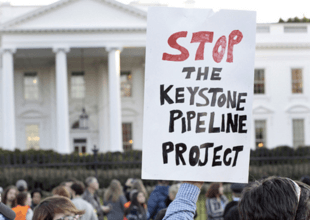 James Marriott, who coordinates Platform’s tar sands work, blogs on the recent news of the Keystone Pipeline victory announced last night.
James Marriott, who coordinates Platform’s tar sands work, blogs on the recent news of the Keystone Pipeline victory announced last night.
The day breaks with fantastic news from Washington DC! The Obama Administration has decided to conduct a review into the planned Keystone XL pipeline – a review of 12 months which may well kill off the project. Keystone XL has been pushed by the tar sands industry, the governments of Canada and Alberta, and the oil refiners in Texas, as a means of bringing diluted bitumen extracted in Alberta to the processing plants on the Gulf Coast. Effectively it would mean the construction of a new ‘oil road’ from the Boreal forests, across the Prairies of the Mid West to the Gulf of Mexico and from thence out to the world. One of the planned destinations for these products refined from tar sands bitumen would be Europe – in part via the terminal at Milford Haven in Wales.
The delay in the construction of this ‘oil road’ has world wide implications not only for the physical distribution of tar sands-derived fuel, but also in wider ways.
Firstly, in the shadow of the failure of the Copenhagen climate talks, many activists in the USA have seen Keystone XL as a totemic site of struggle, and had dedicated huge efforts to blocking the pipeline, recognising it as an essential part of a vast system delivering carbon dioxide emissions into the atmosphere. A piece of industrial technology delivering carbon from the lithosphere of Alberta into the global atmosphere. The US Administration’s decision to delay Keystone is a major victory for the climate justice movement in the US and worldwide – particularly for the likes of 350.org, Greenpeace Canada and our valiant allies UK Tar Sands Network.
Secondly, it’s a victory for the indigenous movements in North America – or rather Turtle Island. Particularly the Indigenous Environment Network who’ve been campaigning tirelessly against the tar sands in Canada, and the Ogallala Sioux who’ve resisted the plans to construct the Keystone XL pipeline across their lands and through the precious Ogallala aquifer.
Thirdly, the delay raises serious questions about the long term plans for the Albertan tar sands province. After the slow up in tar sands projects following the Credit Crunch of 2008, the industry has been going through a period of renewed confidence, encouraged by the intense efforts of the Federal Government of Canada and the Albertan Government to promote the oil province. Industry groups have been boldly pronouncing that production will rise massively from current levels in the coming decade. However this expansion is predicated on the construction of the infrastructure that will deliver tar sands products onto the world market, on the construction of ‘oil roads’ such as the Keystone XL. Now that the pipeline to the Gulf Coast is on hold, and the planned pipeline to the Canadian west coast (the Enbridge pipeline) is facing bitter opposition, questions will be raised over the viability of the aim of expanding tar sands production so rapidly and at such a scale.
And fourthly, because these doubts over the economics of the Canadian tar sands will now raise questions over the wisdom of the investment strategies of those oil companies who have staked so much on the future of this source of unconventional fuel. Shell has 30% of its future reserves in the Canadian tar sands, and although it can today profitably produce from its existing open-pit mines in Alberta, the financial viability of the tar sands projects that it has not yet brought on stream will be questioned. With the delay of Keystone XL and the prospect of the European Commission’s Fuel Quality Directive placing serious constraints on the ability of oil companies to import tar sands-derived fuels into the European Union, it seems that investors in the likes of Shell are facing rising risks in the tar sands.
It’s a grey morning of low cloud in the tidal Thames valley, but the sun is shining on a campaign that we’ve been involved in since 2007.